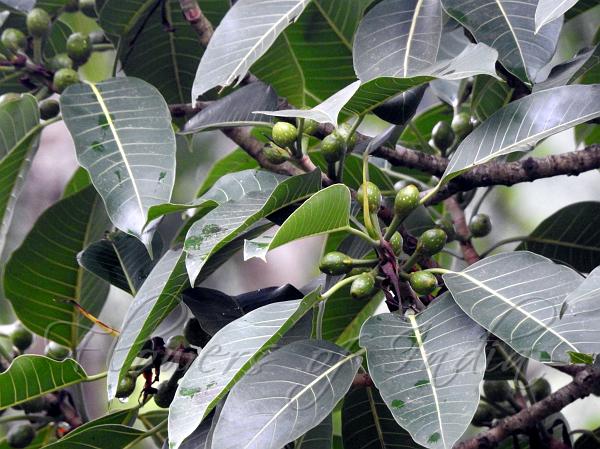|
| South-Indian Fig |
|

|

| File size | 874753 |
| Original date | 4/28/23 5:08 PM |
| Resolution | 4608 x 3456 |
| Flash | Flash did not fire, auto |
| Focal length | 196.0mm |
| Exposure time | 1/60s |
| Aperture | 5.6 |
| Focus Distance | |
| Metering Mode | Multi-segment |
| Camera make | NIKON |
| Camera model | COOLPIX P900 |
| Sensor type |
|
|
|
|
Photo: |
Botanical name: Ficus beddomei Family: Moraceae (Mulberry family)
Synonyms: Ficus rama-varmae
Synonyms: Ficus rama-varmae
South-Indian Fig is a large tree, beginning as
tree-dwelling later become strangler and independent, up to 25 m tall.
Bark is pale brown to yellowish, smooth; blaze cream. Branchlets are
stout, round, hairless, with annular scars, latex white, profuse.
Leaves are simple, alternate, spiral; stipules to 3.5 cm long,
lanceshaped, hairless, falling off leaving annular scars. Leaf-stalks
are stout, 2.5-4 cm long, channeled, hairless; blade 10-25 x 5-15 cm,
ovate, tip tapering, base rounded to almost flat, margin slightly wavy,
thickly leathery, hairless, drying brown; midrib flat above; secondary
nerves 12-15 pairs, looping near margin; tertiary_nerves broadly
netveined. Figs are borne in leaf-axils pairs, ovoid or obovoid,
hairless; flower-cluster-stalk 1.5-2 cm long. Fig is up to 2.5 cm
across, green, spotted with yellow when ripe, stalk stout; achenes,
obovoid, smooth. South-Indian Fig is endemic to the Western Ghats and
Madhya Pradesh.
| Identification credit: Varun Sharma | Photographed in Coorg, Karnataka. |
• Is this flower misidentified? If yes,